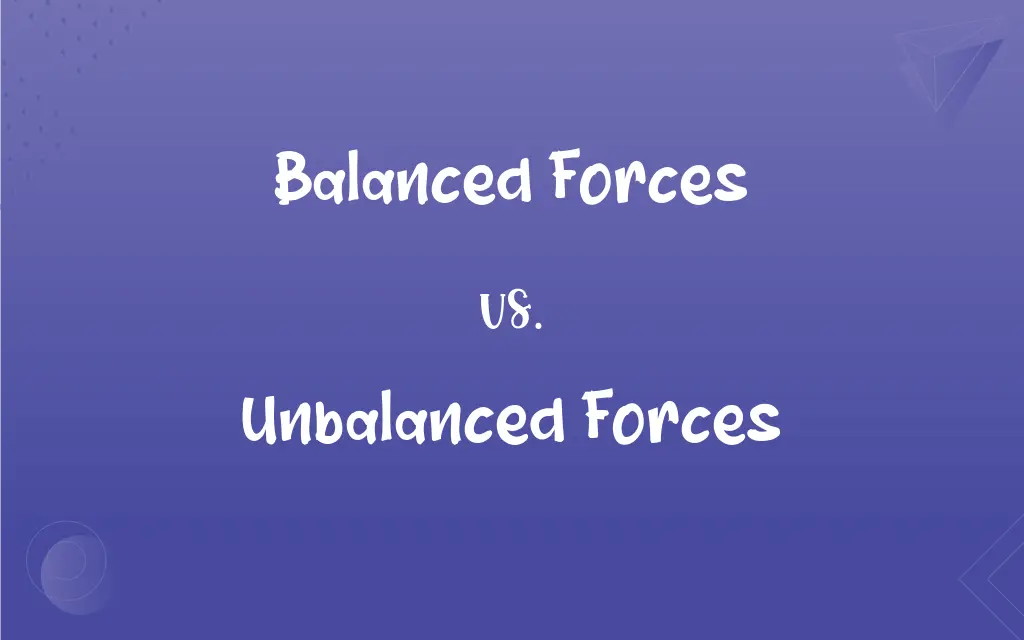Balanced Forces vs. Unbalanced Forces: What's the Difference?
Edited by Aimie Carlson || By Janet White || Published on February 16, 2024
Balanced forces act equally and oppositely on an object, causing no motion change, whereas unbalanced forces result in net force, causing motion change.

Key Differences
Balanced forces occur when two or more forces acting on an object are equal in magnitude but opposite in direction, leading to no change in the object's motion. Unbalanced forces, in contrast, are when forces acting on an object do not cancel each other out, resulting in a change in motion.
In a state of balanced forces, an object at rest remains at rest, or if moving, continues to move at a constant speed in a straight line. With unbalanced forces, an object can start moving, stop moving, or change its speed or direction of motion.
Balanced forces are a condition of equilibrium where the net force is zero. Unbalanced forces create a net force that can accelerate an object according to Newton's second law of motion.
Examples of balanced forces include a book resting on a table where gravitational and normal forces are equal. An example of unbalanced forces is a car accelerating due to a net force from the engine overcoming friction and air resistance.
In a scenario with balanced forces, the forces' effects are neutralized, maintaining the status quo. In unbalanced force scenarios, the stronger force dictates the direction and magnitude of the object's acceleration.
ADVERTISEMENT
Comparison Chart
Resulting Motion
No change in motion
Causes change in motion
Net Force
Net force is zero
Net force is not zero
State of Object
Maintains current state of motion
Changes state of motion
Examples
Book on a table
Car accelerating
Effect on Object's Acceleration
No acceleration
Causes acceleration
ADVERTISEMENT
Balanced Forces and Unbalanced Forces Definitions
Balanced Forces
Balanced forces are equal and opposite forces that result in no motion change.
A vase resting on a shelf experiences balanced forces.
Unbalanced Forces
Unbalanced forces lead to acceleration as per Newton's second law.
A rocket launching into space is propelled by unbalanced forces.
Balanced Forces
Balanced forces do not cause acceleration.
A book lying on a table does not move due to the balanced forces acting on it.
Unbalanced Forces
Unbalanced forces can start, stop, or change the direction of motion.
A car braking suddenly experiences unbalanced forces that reduce its speed.
Balanced Forces
Balanced forces maintain an object's current state of motion.
The balanced forces on a gliding ice skater keep her moving at a constant speed.
Unbalanced Forces
Unbalanced forces cause a change in an object's motion.
A push on a stationary ball causes unbalanced forces, setting it in motion.
Balanced Forces
Balanced forces lead to a net force of zero on an object.
In tug-of-war, when both teams exert equal force, balanced forces are at play.
Unbalanced Forces
Unbalanced forces result in a nonzero net force.
The unbalanced forces on a falling apple accelerate it towards the ground.
Balanced Forces
Balanced forces are a condition of equilibrium.
A suspended stationary object is under the effect of balanced forces.
Unbalanced Forces
Unbalanced forces are responsible for changing an object's velocity.
A gust of wind against a flying kite creates unbalanced forces, altering its path.
FAQs
Can balanced forces move an object?
No, balanced forces cannot move an object; they keep it in its current state of motion.
Are balanced forces always equal in magnitude?
Yes, balanced forces are always equal in magnitude but opposite in direction.
What do unbalanced forces do?
Unbalanced forces result in a net force on an object, causing it to accelerate or decelerate.
What happens when balanced forces act on a moving object?
A moving object will continue to move at the same speed and direction under balanced forces.
What is a real-world example of balanced forces?
A book resting on a table without moving is an example of balanced forces.
Can an object be in equilibrium under unbalanced forces?
No, an object cannot be in equilibrium under unbalanced forces; equilibrium requires balanced forces.
Do balanced forces always cancel each other out?
Yes, balanced forces cancel each other out, resulting in no net force.
What are balanced forces?
Balanced forces are equal and opposite forces acting on an object, resulting in no net force and no change in motion.
What causes an object to accelerate?
An object accelerates due to unbalanced forces acting upon it.
How do unbalanced forces affect a stationary object?
Unbalanced forces can set a stationary object in motion.
Are gravitational forces always unbalanced?
Not necessarily. Gravitational forces can be balanced by other forces, like normal force.
What is an example of unbalanced forces in everyday life?
Kicking a soccer ball, which changes its motion, is an example of unbalanced forces.
Can balanced forces exist in a vacuum?
Yes, balanced forces can exist in a vacuum as they depend on the forces acting on the object, not the environment.
How can balanced forces be identified?
Balanced forces can be identified when there is no change in the object's motion, indicating no net force.
Can unbalanced forces change an object’s direction?
Yes, unbalanced forces can change an object's direction of motion.
How do unbalanced forces relate to Newton's second law?
Newton's second law states that force equals mass times acceleration, which is the principle behind unbalanced forces causing acceleration.
Can an object have multiple forces acting on it and still be balanced?
Yes, if all the forces acting on an object are equal and opposite, the forces are balanced.
Do unbalanced forces always cause motion?
Unbalanced forces always cause a change in motion, either starting, stopping, or changing the direction or speed of the object.
What determines the magnitude of acceleration in unbalanced forces?
The magnitude of acceleration is determined by the net force and the mass of the object, as per Newton's second law.
Are unbalanced forces necessary for circular motion?
Yes, unbalanced forces, like centripetal force, are necessary to change the direction of motion in circular motion.
About Author
Written by
Janet WhiteJanet White has been an esteemed writer and blogger for Difference Wiki. Holding a Master's degree in Science and Medical Journalism from the prestigious Boston University, she has consistently demonstrated her expertise and passion for her field. When she's not immersed in her work, Janet relishes her time exercising, delving into a good book, and cherishing moments with friends and family.
Edited by
Aimie CarlsonAimie Carlson, holding a master's degree in English literature, is a fervent English language enthusiast. She lends her writing talents to Difference Wiki, a prominent website that specializes in comparisons, offering readers insightful analyses that both captivate and inform.
































































